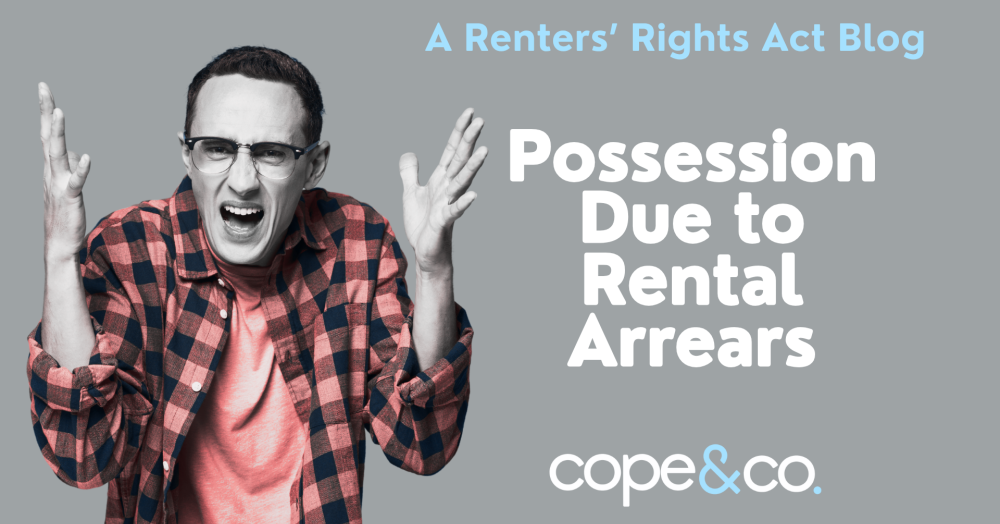
Possession Due To Rent Arrears Explained
Landlords, brace yourselves: under the Renters’ Rights Act, rent arrears just got tougher to tackle. Higher thresholds, longer notice periods, and probable court backlogs mean you could be waiting months with no rent. Here’s what’s changing - and, more importantly, how to protect your cashflow before arrears severely damage your portfolio...
Rent arrears remain one of the biggest headaches for landlords. When tenants stop paying, it’s not just lost income, it’s mortgage stress, legal costs, and months of uncertainty. With the Renters’ Rights Act extending notice periods and possible court delays mounting, the risk of arrears hitting hard has never been greater and the preventative measures that you need to take have never been more important.

🔵 Section 8 will be your main route
With Section 21 set to go, rent-arrears cases will run through Section 8. The Act keeps the familiar split between mandatory and discretionary grounds - but tightens thresholds and timelines. The Renters' Rights Act confirms two key shifts for arrears cases:
🔹 Ground 8 (mandatory “serious arrears”)
The threshold for the amount of arrears rises from 2 months to 3 months’ rent due both at the serving of the notice and at the time of the hearing. The notice period to inform your tenant that proceedings are to begin increases to 4 weeks from 2 weeks.
🔹 Discretionary arrears grounds (10 & 11)
These are available to use as tools for possession: any arrears at hearing (Ground 10) and persistent late payment (Ground 11) with 4-week notice. These grounds are particularly useful where the debt is under three months or dips below the Ground 8 threshold right before the court hearing.
Two more wrinkles landlords should note:
⚠️ Universal Credit delays won’t count towards Ground 8 where the tenant was entitled to Universal Credit so rely on Grounds 10/11 and your evidence if benefits processing is the issue.
⚠️ Compliance pre-conditions tighten: If you haven't protected the deposit in line with the regulations, or, once it is in operation, registered on the new 'Private Rental Sector' database, the court can refuse possession on most grounds, although Anti Social Behaviour exceptions do apply.
Don’t give the judge a reason to throw your claim out.

🔵 Court timelines are lengthening so plan for the cashflow gap
For landlords, possession proceedings are already a last resort.
The latest Ministry of Justice statistics reveal that even when eviction becomes unavoidable, the wait for a resolution is getting longer.
Between April and June 2025, the average time from claim to repossession under the Section 8 eviction process stretched to 27.9 weeks - that's over six months from start to finish. This is up from 25.4 weeks during the same period last year. Apart from the exceptional years of 2020-2021, when repossessions were suspended during the pandemic, this is the longest wait landlords have faced since 2017.
The 27.9 weeks is the court process alone, before you even add the 4-week notice, time to issue the claim, and bailiff lead times.
Probable court backlogs are a genuine concern. In practice, landlords could be looking at 7–9 months from first missed rent to vacant possession when a case runs the full course.
Sector bodies warn that abolishing Section 21 will push more cases onto an already stretched court system, risking further delay unless capacity improves.

🔵 When will this bite?
The Bill attained Royal Assent in late October and implementation likely in May or June 2026 (the official Parliament page and leading charities reflect this late-stage status/timeline). Plan now; don’t wait for commencement day.

🔵 What this means in real life
🔹 Ground 8 is harder to hit and easier to fall off. A payment from the tenant just before the hearing that takes arrears under 3 months nullifies the mandatory ground. Always plead Grounds 10 and/or 11 alongside Ground 8 to give the judge a discretionary route. Keep impeccable records of payments, promises, and broken arrangements.
🔹 Cashflow exposure increases. A 4-week notice + slower courts = longer periods with partial/no rent. Budget for that risk on every tenancy.
🔹 Process mistakes are costlier. Fail to protect a deposit or register on the PRS database and you may be locked out of possession. Pre-issue compliance checks become non-negotiable.
🔵Proactive moves to reduce arrears risk
1) Upgrade tenant selection (evidence beats vibes)
🔹 Use Stringent Affordability Ratio's - e.g Cope & Co. use; Total Annual Gross Income must be equal or greater than 30 x monthly rent, (36 x for Guarantors) in conjunction with payslips, employment letters, and open-banking income traces where possible.
🔹 Use Credit and conduct checks that flag CCJs, defaults, and high unsecured debt.
🔹 Obtain previous landlord reference that specifically confirms payment history and notice compliance.
🔹 Verify household composition (who’s actually living there), and confirm who’s legally on the tenancy agreement and liable for the rent.
For variable/UC income, obtain managed payment arrangements information and set clear expectations early.
🔹 Where affordability is marginal, consider a deed of guarantee from a UK-based guarantor with verified income or take out Rent Guarantee Insurance (RGI) from day one.
2) Take out Rent Guarantee Insurance (and keep it valid)
🔹 Choose a policy that covers missed rent from day 1, minimal or NIL excess, legal expenses, and vacant possession.
🔹 Tie your Rent Guarantee policy renewal to your annual rent review so cover scales with any increased rent.
🔹 Be scrupulous with policy conditions: referencing standards, claim time limits, serving the correct Section 8 notices on the current prescribed forms, and using all applicable grounds. A technical slip is a common claims killer.
3) Run a tight arrears protocol (week-by-week)
🗓️ Day 1: automated reminder; confirm payment method; check bank issues/Universal Credit timing.
🗓️ Day 7: formal arrears letter; offer a short-term plan without waiving your rights.
🗓️ Day 14: escalate—warn of pre-action costs, signpost debt/benefit advice (helps in court).
🗓️ Day 21–28: review plan compliance; if arrears trend towards 3 months, prepare Section 8 with Grounds 8 and 10/11.
🔹 Keep call notes, emails, screenshots, and a running account statement - judges love good bundles!
4) Draft smarter tenancy agreements
🔹 Have clear rent-due mechanics (dates, method, late-payment protocol).
🔹 Detail possible Interest/charges (within legal limits) to deter persistent lateness.
🔹 Include communication clauses allowing notices via multiple channels.
5) Stress-test cashflow
🔹 Assume two consecutive missed rents can become six-plus before resolution.
🔹 Ring-fence a voids/arrears reserve per property (e.g., 1–2 months’ rent).
🔹 If leveraged, check your lender’s arrears and consent-to-let covenants so your own cashflow doesn’t trigger a breach.

Building a winnable case (when you do need court)
🔹 Serve all viable grounds (8 + 10/11) with correct notice periods and current prescribed forms; keep proof of service.
🔹 Bundle quality: chronological arrears schedule, bank statements, correspondence, repayment offers, missed-payment diary, and notes of support signposting.
🔹 Ask for alternative orders: where Ground 8 fails on the day, press the judge for possession on Grounds 10/11, or a suspended order on strict terms.

🔵 Bottom line...
The Act doesn’t remove landlords’ ability to recover properties for non-payment - but it raises the bar for mandatory arrears and stretches timelines that were already long. The winners will be landlords who front-load risk control (better tenants and Rent Guarantee Insurance), stay watertight on compliance, and document everything.
If you’d like help tightening your arrears protocol, selecting stronger tenants, or setting up rent guarantee cover, we can sort that for you and build it into your lettings and management plan.
Phew! - It would be much less stressful if Cope & Co. did all of that wouldn't it?

LetSimple is our unique, stress-free way to let us take care of everything. One monthly subscription, no hidden fees, and rent guarantee built in, so you can relax knowing your income is protected.
Click the image below to see how LetSimple gives landlords comfort, compliance, and complete peace of mind.












